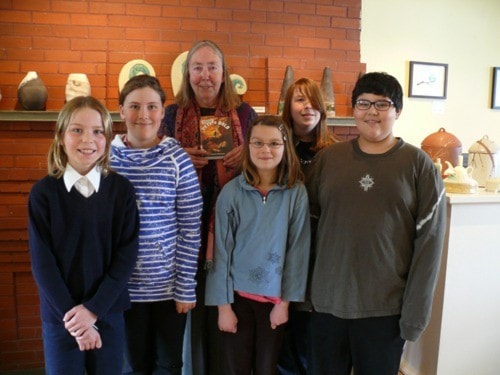Grades 4 to 7 students from Fernie put an award winning author in the hot seat last week.
Luanne Armstrong came to The Arts Station on Thursday, April 28 at 11 a.m. to do a book reading, and was met with lots of questions the kids had prepared about writing books.
Armstrong has been nominated for a Red Cedar book award and is touring the Kootenays promoting her book, Pete’s Gold.
Pete’s Gold is an adventure story for kids that tackles far more than finding treasure. Ghosts, a skeleton in a cave and getting lost across the lake, go hand in hand with harder issues like family break-up and illness, issues any contemporary kid may grapple with.
The event was sponsored by the Kootenay Library Federation, the Canada Council for the Arts and the Fernie Heritage Library.
The Fernie kids who have been attending the Red Cedar book club at the library since October had lunch afterwards with Luanne and asked her some interview questions they had prepared.
India Stewart
“I am really into reading and writing and so it was a big deal for me to be able to meet an actual published author. With Luanne Armstrong telling us all about the benefits of being an author, and the secrets to writing success, I became really inspired. I even thought up an idea for a story! Since she is touring through the Kootenays, I bet that lots of young writers will learn to perfect their skills with the tips and advice that she gave us.”
Q. What kind of lead is best to start a story with?
A. A good trick is to begin your story with action; something happens that is dangerous, scary, and adventurous.
Q. Do you like writing children’s books more than adults’?
A. I love the library, and I often just reads lots and lots of children’s books, to get ideas for my stories. Kids’ books are more fun because they’re not as serious and you can play around with fantasy.
Q. What is the most key ingredient in a good children’s story?
A. There are three important things: to have a character that entertains your reader as well as one you like, an adventure that is interesting and cool so the reader can follow, and also make sure the character learns something important in the end, so that they change.
Q. Is it possible to write a book through the main character’s eyes and then have that character die?
A. No, but they can if it’s at the end; but, your readers will hate you if you do.
Q. Is there any advice you have for naming characters and giving them personalities?
A. Naming characters is tricky but a good technique is to buy or look at a baby’s name book, just flip through it until you find a name that sticks in your mind.
Q. How do you know when to wrap up a story?
A. Well, for your first draft, never stop writing! Just let it all out and then edit and cut until it feels right.
Q. Do you believe that children are better writers than grown-ups?
A. Children often have really creative, great ideas but they never have time with school and all to focus on their writing. Most young writers are home schooled.
Q. Was there a main message you were trying to tell through Pete’s Gold?
A. Yes, if you really want to do something always try and do it. Persevere and you will accomplish it. That is the main message.
Astrid Bloemink
Q. What inspired you to be a writer?
A. Reading. I love to read. I like all books.
Q. What gave you the idea to write Pete’s Gold?
A. Pete’s Gold is based on a true story about the farm I live on.
Q. How long did it take to write Pete’s Gold?
A. It took six months because it did not come to me all at once. It came to me in chunks.
Q. What is it like being an author?
A. It is fun. I think of it as being able to day dream all day and write down my thoughts.
Q. How do you get the names of your characters?
A. I make a character that does not have a name and I think of someone I know that has a personality like the character. Then I name the character after them.
Q. How do you get the main character on an adventure?
A. First of all, you get that character into trouble, then even more trouble, then even more trouble. Then you find a way to get them out of trouble.
